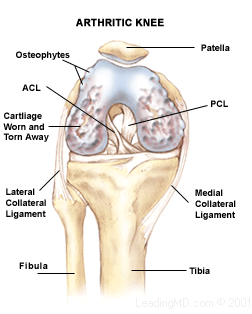|
 History
History
Patients with knee arthritis usually describe a gradual onset of
knee pain, restricted motion and activities, and pain at rest.
The
physical examination
Findings of knee arthritis may include:
painful gait on the involved side which causes a limp.
a
a knock-kneed or bowlegged condition.
Most often there is a loss of complete extension (flexion
contracture), and the inability to fully bend the knee.
Very often there is swelling.
Frequently bone spurs may be felt
on the inside or outside of the joint.
When the knee is moved through
a range of motion, crepitus is present.
There is usually tenderness around
the inside and outside portions of the joint line.
It is important to distinguish knee arthritis from hip arthritis
or disc degeneration in the lumbar spine, since the symptoms are similar.
Diagnostic
test and imaging
Usually, plain X-rays will show the presence of arthritis and any
abnormalities in the alignment of the lower leg and changes in the
mechanical axis. MRI scanning is usually not necessary to diagnose
knee arthritis. There are four classic features of knee arthritis:
- Joint space narrowing
- Flattening of the femoral
condyle (the end of the femur)
- Subchondral sclerosis
(reactive bone thickening)
- Peripheral bone spur formation
 
© 2015 by LeadingMD.com All rights reserved
Disclaimer
|
|
Stem cells, PRP, and HA, oh my! We are not in Kansas anymore… Part 2
READ MORE >>
|
|
|
|
